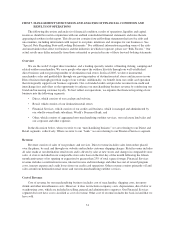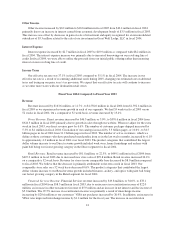Cabela's 2005 Annual Report Download - page 47
Download and view the complete annual report
Please find page 47 of the 2005 Cabela's annual report below. You can navigate through the pages in the report by either clicking on the pages listed below, or by using the keyword search tool below to find specific information within the annual report.•Changes in segment mix. We record the direct labor expenses of our Retail segment and all of the costs
of our Financial Services segment in selling, general and administrative expenses. Therefore, an
increase in the revenue of those segments will generally be accompanied by an increase in selling,
general and administrative expenses. In addition, as discussed above, our Financial Services segment
does not have costs classified as cost of revenue. If revenue in our Retail or Financial Services segments
grow at a disproportionate rate compared to our Direct segment, our results will reflect the
disproportionate effect on gross profit and selling, general and administrative expenses that results from
our classification of these expenses.
•Seasonality. Our revenue is seasonal in nature due to holiday buying patterns and hunting and fishing
season openings across the country. Our merchandise revenue is typically higher in the third and fourth
quarters than in the first and second quarters. See “Quarterly Results of Operations and Seasonal
Influences.”
•Compensation Charges for New Accounting Pronouncements. On December 15, 2004, the FASB issued
FASB Statement 123R, Share Based Payment (“Statement 123R”). This revises the previously issued
FASB 123. It requires public companies to record compensation at fair value for newly issued options
and for remaining outstanding unvested options as of the effective date, which is for periods beginning
after December 15, 2005. We expect to incur a total non-cash pre-tax compensation charge for
outstanding unvested options and employee stock purchase plan discounts of approximately $2.3 million
during fiscal 2006. This does not include charges for any new option grants that may be approved during
fiscal 2006.
•Land sales impact on other revenue. In fiscal 2005, the amount of land sales increased over fiscal 2004
by $17.7 million to $25.2 million compared to $7.5 million in fiscal 2004. These land sales are included
in other revenue and pertain to development of land around our destination retail stores. The cost of the
land is reflected in cost of sales as this land was held for sale. The timing of the land sales and the
varying gross profit of these land sales can have an impact on our annual and quarterly results. The
margin on the sales of land can vary significantly depending on the circumstances and development plan
for each location. Total gross profit on our land sales was $4.4 million, or 17.5% of land sales, in fiscal
2005 compared to $2.8 million, or 37.3% of land sales, in fiscal 2004.
•Number of weeks in our fiscal periods. Our fiscal year ends on the Saturday closest to December 31 and,
as a result, a 53rd week is added every five or six years. Fiscal year 2003 consisted of 53 weeks ended on
January 3, 2004. Fiscal years 2005, 2004, 2002 and 2001 consisted of 52 weeks. Our fiscal year policy
only impacts our retail and direct segments. Our bank’s fiscal year ends on December 31st and therefore
is not impacted by the 53rd week.
Shelf Registration
On September 2, 2005, we filed a Form S-3 Registration Statement to register 6,252,768 shares of common
stock. The shares of common stock being offered in the registration statement by selling stockholders are
issuable upon conversion of 6,252,768 shares of non-voting Class B common stock. We will not receive any of
the proceeds from the sale of shares of common stock in this offering. The timing and amount of any sale are
within the sole discretion of the selling stockholders.
35
























